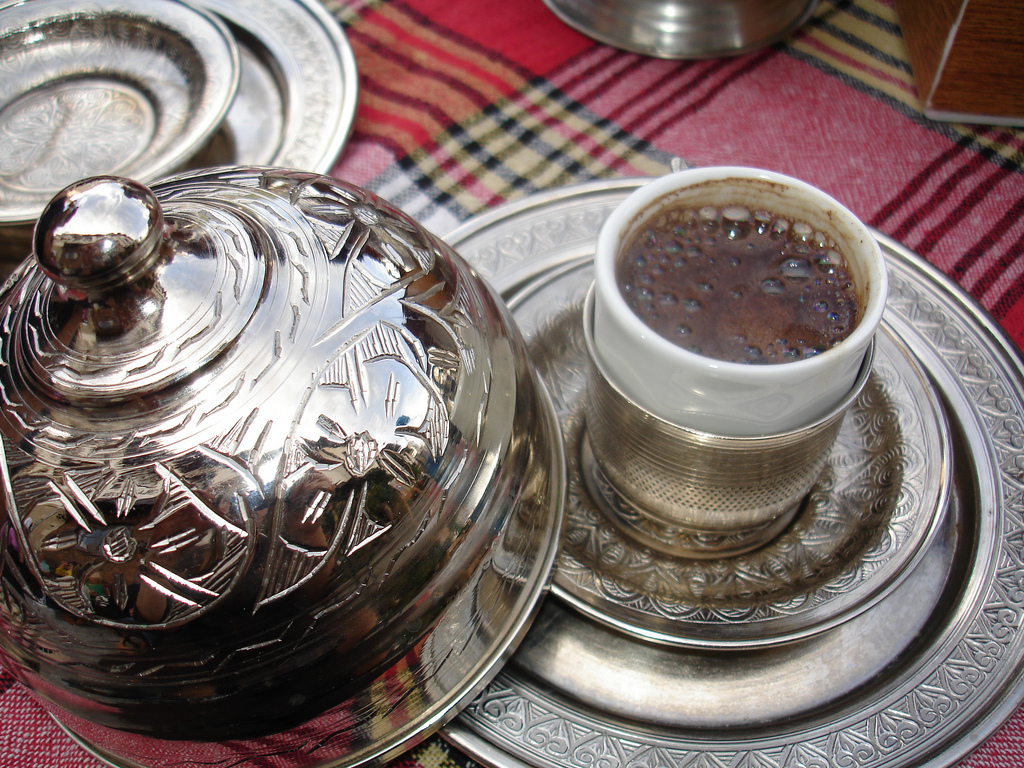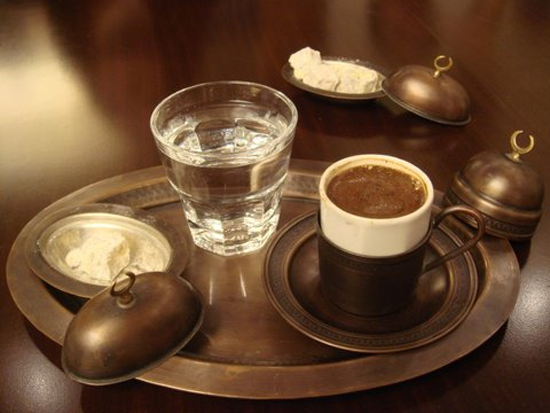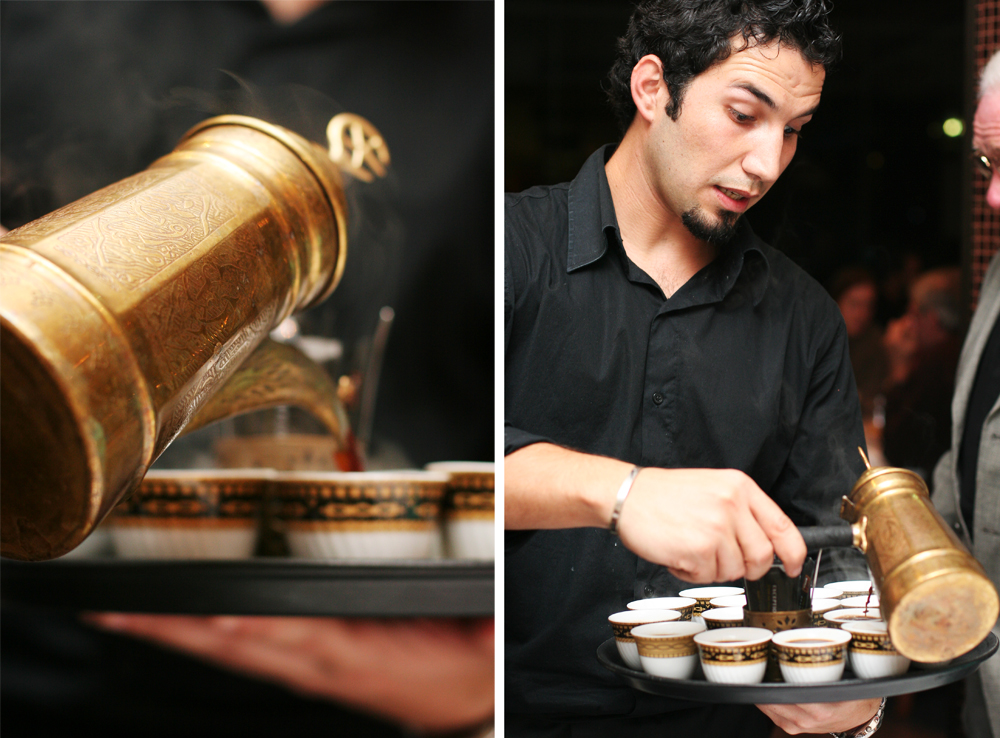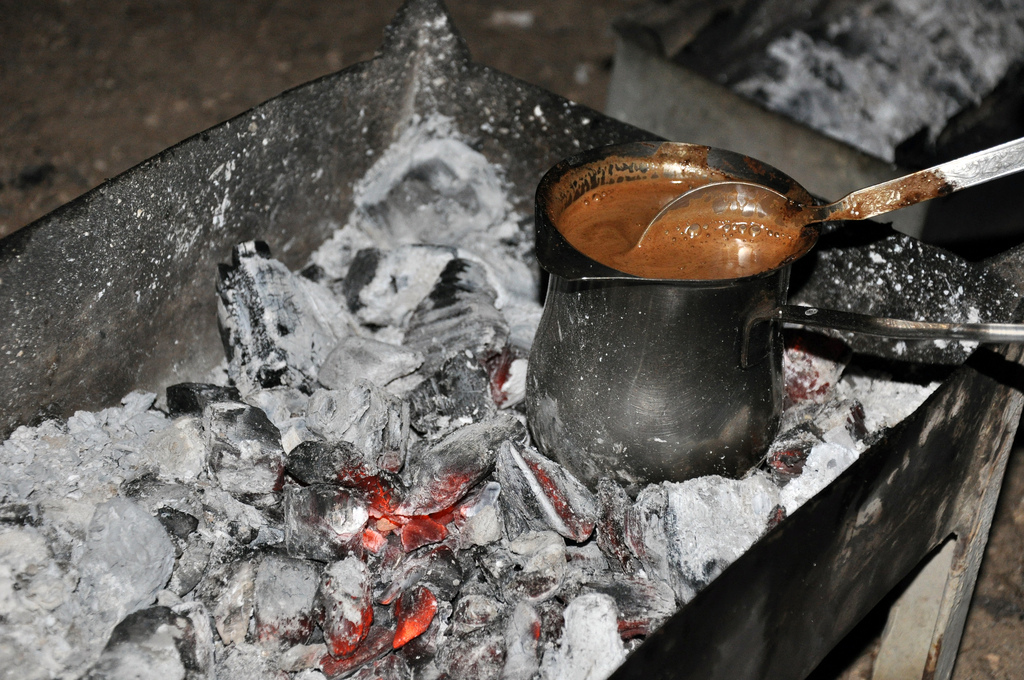by M. Butcher
Coffee has long history in the world, from humble beginnings in a story about a goat herder who noticed his goats got excited after eating the coffee berries to the widespread cafés and coffee shops all over the world. Coffee is believed to have been brought to Istanbul in 1555 by two Syrian traders, although others claim that it arrived much earlier than that, around 1517. Coffee has come a long way since then, we find different types and ways to brew it different parts of the world. The Turkish have a particular way to make coffee and it has been adopted and modified into many cultures in the Arab world and aboard.
The Turkish way to make it is simple; the beans are usually freshly roasted, ground to a fine powder with cardamom (or it can be made without). It is made in a pot called a cezve or kanaka, usually for one person, with one or two heaping teaspoons of coffee, sugar and about 90 ml of cold water. The coffee and sugar are added to the water, it is stirred to dissolve the sugar then it is set on a gas stove over low heat to let the coffee come to a slow boil and develop little bubbles on the surface and a slight change in colour of the top of the coffee, creating “foam”. It will then be taken off the stove and the “foam” can be lifted off and put into cup. It is then set on the heat to boil again two more times. The coffee should be thick and uniform. The better the coffee maker the better the “foam”.
There are different types of sweetness:
- sade means no sugar
- az şekerli means little sugar (1/2 teaspoon)
- orta şekerli means medium sugar (1 teaspoon)
- çok şekerli means lots of sugar (1 ½ to 2 teaspoons)
The coffee is left to settle for a few moments and then poured into small cups and usually served with a glass of cold water and Turkish delight. In some parts of Turkey, they add pistachios to the coffee.
Due to the spread of the Ottoman Empire, Turkish coffee was brought into many parts of Europe. It is made in Cyprus, where it is called Cypriot Coffee. The coffee pot used to make it is called Briki. In Croatia, it is known as Turška Kava, or just Kava in many places there. In Greece, it is called Greek Coffee. In Romania, it is called Cafea Turcească, Cafea Caimac or Cafea la Ibric (as the pot it is made in is called an ibric). In Serbia, it is called Domestic Coffee or Kафа Coffee. In Slovinia, it is called Turška Kava, or if it is strong, it is called Črna Kava or Black Coffee.
Lebanon
Lebanese coffee starts with hot water alone, to which sugar is added and dissolved. It becomes sugar syrup with a higher boiling point than water. The coffee (ground with cardamom if desired) is added, and the mixture is stirred. It is then brought to a boil two or three times. It is said to extracts more flavour without giving it the taste of over-boiled coffee.
Jordan
In Jordan, Turkish coffee is made with boiled water, a heaping spoonful of coffee and sugar, as desired. It is set on low heat and stirred until homogeneous then left to rise, it is removed and left to sit, then put back on the stove to boil, this is repeated 4 or 5 times. It is meant to bring out the full flavour of the coffee, and then it is removed to let it settle and be served. It has no foam.
Bosnia/ Serbia
In the Balkans, the way is to fill the džezva (kanaka) with cold water only, and heat it until it boils. As the water boils coffee is added, stirred, and removed from the fire before the foam boils over. After the foam settles the pot is placed back onto the heat source so the water would boil again, releasing more caffeine and flavour. The last step can be skipped to preserve the foam.
Egypt
The Egyptians have another way, which is similar but uses different terms. It is called “ahwaa”. It is made in a kanaka, with a heaping spoon of finely ground coffee and cold water, and sugar to each person’s taste. The sugar and coffee are put into the pot then the cold water is added, some people stir it, but it is not necessary.
There are different types of sweetness:
- Saada (سادة) means unsweetened
- ‘ar reeha (على الريحة) means slightly sweetened
- Mazboot (مضبوط) means sweet
- Ziyaada (زيادة) means very sweet
It is set on low to slowly come to a boil, it will bubble and change colour on the top, and starts to rise out of the kanaka, creating the “crème” or “foam” called face. Some say if it has good face, then it’s lucky! Egyptians enjoy their “ahwaa” in small cups with or without a handle called Finjan (فنجان), usually ornate with gold designs on them, and it is accompanied by a cold glass of water.
Morocco
Traditionally, Arabic coffee beans are roasted on a charcoal fire and ground in a mortar. One of the secrets of making Arabic coffee is to roast the coffee and within minutes, brew it. One teaspoon of sugar and one cup of water is boiled together until the sugar dissolves. When the water is clear, the ground Arabic coffee is added to the water and stirred. When foam rises to the top of the pot, the pot is removed from the fire and set aside until the foaming stops. Return the coffee back to the fire and allow it to boil at least two more times. After the last time, a few drops of cold water are added to the coffee to settle it. It is served in small cups called Finjal.
There are different types of sweetness:
- Murrah (مُرَّة) means no sugar
- Mazboutah (مضبوطة) means medium
- Hilweh (حلوة) means sweet
Turkish coffee is an acquired taste, the first time I tried it I didn’t care for it, but another go round, a cool glass of water, and it grew on me. It has become part of my husband’s daily routine where he has his coffee mid morning to get him through until siesta time.
Whenever you decide to visit Turkey or an Arab country you should try some Turkish coffee, even if it doesn’t tickle your taste buds right way, it’s an experience you can’t let pass you by. If you live in Europe or North America, or anywhere else outside the Arab world, it is very easy to try it still, just find the nearest Arab or Greek or Turkish grocer and you’ll find all you need to make it yourself at home, so go on, indulge a little.
For more about Turkish Coffee:
http://en.wikipedia.org/wiki/Turkish_coffee
www.mehmetwfendi.com/mehmetefendi/eng/pages/tk8.htm
http://www.travel-exploration.com/subpage.cfm/Coffee
http://almashriq.hiof.no/general/600/640/641/khayat/appendix/coffee.html
My friend Dana; thank you for the tips about making Turkish coffee in Jordan.












